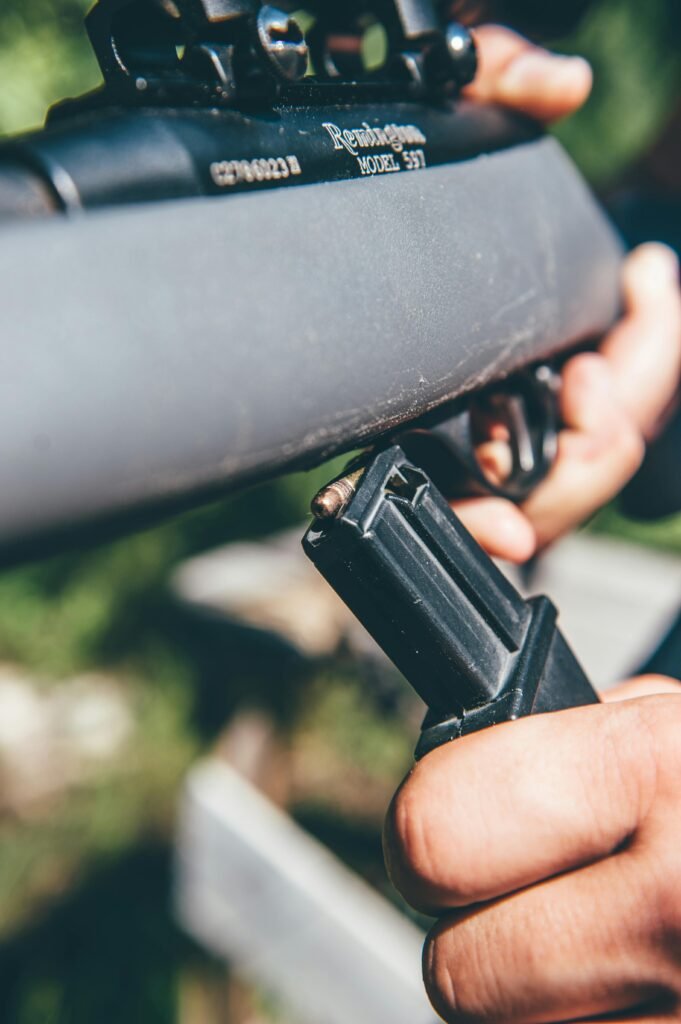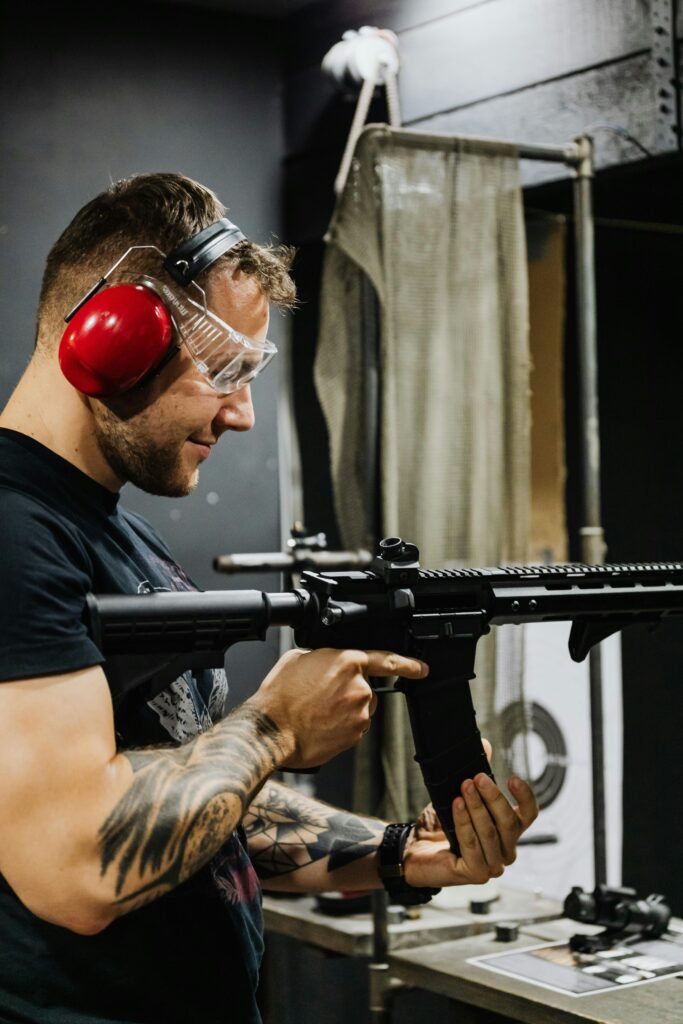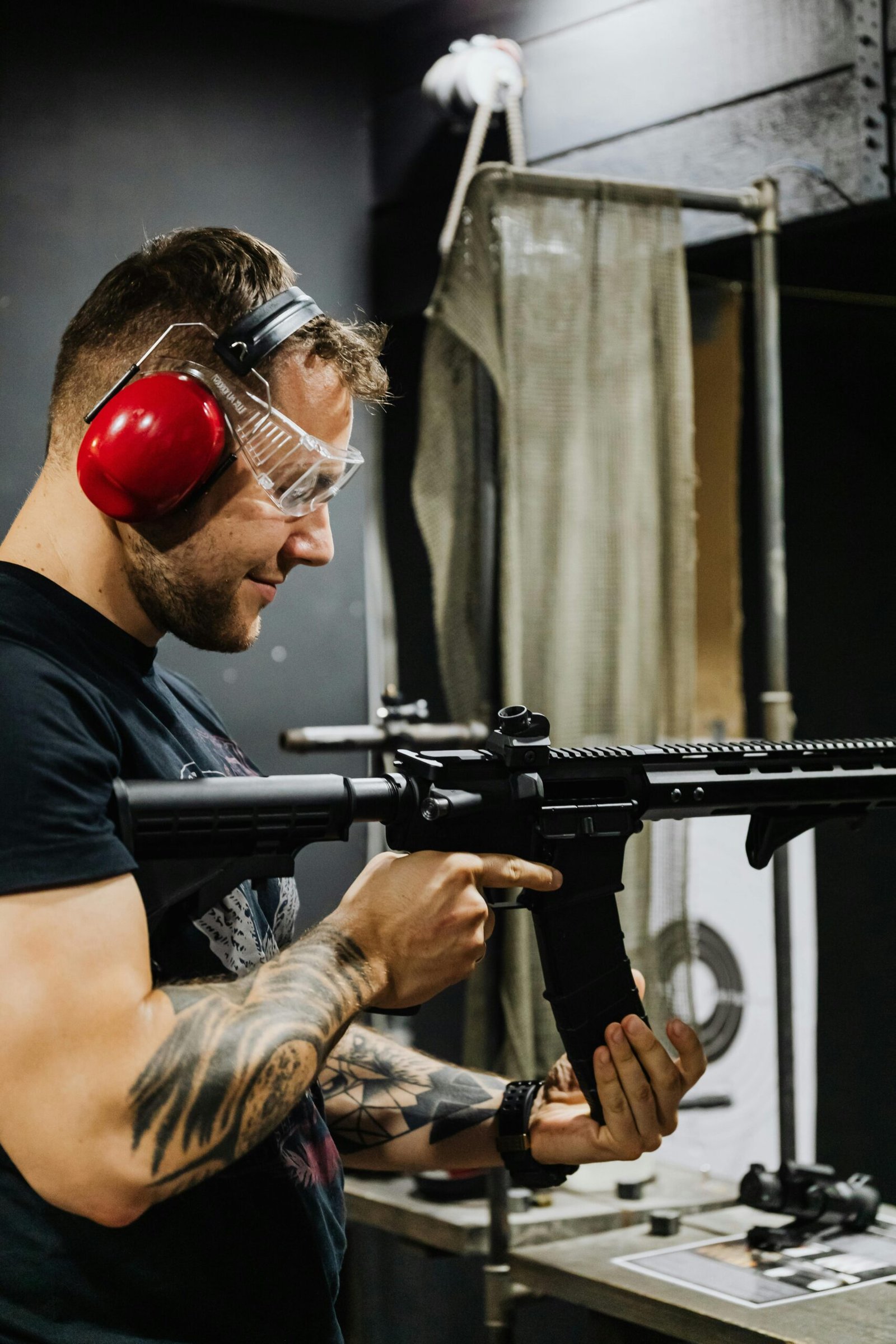Driving across state lines can be an exciting opportunity to explore new destinations or visit loved ones, but it also comes with the responsibility of understanding and adhering to each state’s regulations. One area that requires particular attention is the carry of firearms in vehicles. State-specific regulations on carrying firearms in vehicles vary, and it’s essential to be well-informed to ensure compliance and peace of mind while on the road. This article will provide a comprehensive overview of state-specific regulations on carrying firearms in vehicles, empowering you with the knowledge needed to navigate these laws confidently and responsibly.

This image is property of images.pexels.com.
Overview of State-Specific Regulations
Different laws in different states
When it comes to carrying firearms in vehicles, it’s important to note that each state has its own set of regulations governing this practice. While some states may have lenient laws allowing open carry or easy access to firearms, others may have stricter regulations that require permits or limit the types of firearms allowed. It can be confusing to navigate these differences, especially if you frequently travel across state lines.
Importance of understanding state laws
Understanding the state-specific regulations for carrying firearms in vehicles is crucial for anyone who wishes to exercise their Second Amendment rights while on the go. Failure to comply with these laws can result in legal consequences, which can range from fines to imprisonment, depending on the severity of the violation. By familiarizing yourself with the regulations in the states you visit, you can ensure that you are operating within the bounds of the law and avoid unnecessary legal issues.
Conflict between state and federal laws
One of the challenges faced by firearms owners is the conflict between state and federal laws. While a particular state may have laws that permit certain carry modes or provide exceptions for specific situations, federal laws may impose additional restrictions. It’s important to be aware of these conflicts and understand which laws take precedence in different situations. In general, federal laws often regulate the transportation of firearms across state lines, while state laws govern the carry modes and accessibility within individual states.
Permissible Carry Modes
Unloaded firearms
In some states, it is permissible to carry an unloaded firearm in a vehicle. This means that the firearm must not be loaded with live ammunition and must be stored separately from any ammunition, such as in a locked container or a secure storage compartment. While unloaded carry may be allowed in certain situations, it’s essential to check the specific laws of each state you plan on visiting, as the regulations can vary.
Loaded handguns
Many states allow for the carry of loaded handguns in vehicles, either openly or concealed, without the need for a concealed carry permit. This means that as long as you meet the eligibility requirements to possess a firearm, you can carry a loaded handgun in a vehicle without additional permits. However, it’s important to research and understand the laws of each state, as some may have additional restrictions or require permits for loaded carry.
Concealed carry permits
Some states require individuals to obtain a concealed carry permit in order to carry a concealed firearm in a vehicle. These permits typically require background checks, training, and other eligibility criteria. If you plan on carrying a concealed firearm in your vehicle, it is essential to obtain the necessary permits in the states that require them. Failure to do so may result in legal consequences.
Open carry laws
While open carry may be permitted in certain states when on foot, the laws regarding open carry in vehicles can be more restrictive. Some states may completely prohibit the open carry of firearms in vehicles, while others may have specific requirements, such as the firearm being unloaded and securely stored. If you plan on open carrying in a vehicle, it’s vital to research and understand the laws of each state to ensure compliance.

This image is property of images.pexels.com.
Transportation Requirements
Secure storage
In many states, firearms transported in vehicles must be stored securely. This means that the firearm must be in a locked container or secured in a manner that prevents unauthorized access. Secure storage requirements are aimed at promoting safety and preventing incidents of accidental discharge or unauthorized use of firearms.
Locked compartments
Some states require firearms to be stored in locked compartments, such as glove boxes or center consoles, while being transported in a vehicle. These locked compartments provide an additional layer of security and help ensure that the firearm is not easily accessible to unauthorized individuals, such as children or thieves.
Trunk requirements
Certain states require firearms to be transported in the trunk of a vehicle, rather than in the passenger compartment. This requirement helps keep the firearm out of reach and out of sight, minimizing the potential for theft or accidental discharges.
Exceptions for certain vehicles
Some states provide exceptions to firearm transportation requirements for specific types of vehicles, such as motorcycles or recreational vehicles. These exceptions may allow for alternative methods of secure storage or accommodate the unique limitations of these vehicles. It’s crucial to be aware of these exceptions to ensure compliance with the law while traveling in different types of vehicles.
Transit through different states
It’s important to note that the transportation requirements for carrying firearms in vehicles can vary when traveling through different states. Even if a particular state allows for the carry of firearms, it does not necessarily mean that you can transport them through other states without complying with their regulations. It’s crucial to research and understand the laws of each state you plan on traveling through to avoid unintentional violations.
Public Access vs. Private Property
Carrying in public places
Carrying firearms in public places, such as parks or streets, can be subject to specific regulations that vary from state to state. While some states may allow for open carry or concealed carry in public spaces, others may have strict restrictions or prohibit carrying altogether. It’s essential to understand the laws of each state regarding carrying firearms in public areas to ensure compliance and avoid legal issues.
Limits on private property
While individuals generally have the right to possess firearms on their own private property, there may be limitations and responsibilities that come with this right. Some states allow property owners to restrict or prohibit firearms on their premises, even if the owner possesses a valid concealed carry permit. It’s important to respect these limitations and understand the policies of private property owners to avoid potential conflicts.
Business establishment policies
Certain businesses, such as bars, schools, or government buildings, may have policies that prohibit the carry of firearms on their premises. While these policies may not be legally binding, violating them may result in being asked to leave the premises or facing other consequences. It’s crucial to respect the policies of business establishments and be aware of any posted signs or notices regarding firearms.

This image is property of images.pexels.com.
Stand Your Ground and Castle Doctrine
Understanding self-defense laws
Stand Your Ground and Castle Doctrine laws provide legal protection to individuals who use firearms in self-defense. Stand Your Ground laws generally allow individuals to use deadly force if they believe they are in imminent danger, regardless of whether they have a duty to retreat. Castle Doctrine laws provide similar protections within one’s own home or vehicle, granting the right to defend oneself without fear of prosecution or civil liability.
Duty to retreat vs. stand your ground
While some states have a duty to retreat requirement, which means that individuals must attempt to safely withdraw from a dangerous situation before using deadly force, others have stand your ground laws that eliminate this duty. It’s essential to understand the self-defense laws of each state you visit, as they can have a significant impact on your rights and legal obligations in potentially threatening situations.
Protection within your home or vehicle
Castle Doctrine laws often extend protections to individuals within their own homes or vehicles, recognizing the inherent right to defend oneself and loved ones in these private spaces. They provide legal justification for the use of firearms in self-defense without the need for a duty to retreat. However, it’s important to note that these protections may vary from state to state, and understanding the specific laws is crucial to ensuring compliance.
Prohibited Places and Exceptions
Schools and educational facilities
Federal law generally prohibits firearms within school zones, and many states enforce additional restrictions regarding carrying firearms near schools or within educational facilities. It’s crucial to understand the specific regulations of each state, as violations of these laws can result in severe legal consequences.
Government buildings and facilities
Carrying firearms in government buildings or facilities, such as courthouses or state capitols, is often subject to strict regulations. These restrictions are in place to ensure the safety of individuals within these spaces and to maintain order. It’s important to be aware of any posted signs or security measures that may indicate firearms are not allowed in these locations.
Places of worship
Many states have specific regulations regarding carrying firearms in places of worship. While some states may prohibit carrying firearms within these establishments, others may allow it under certain circumstances or with the permission of religious leaders. It’s essential to respect the policies and wishes of each place of worship and understand the laws of the state you are in to avoid potential conflicts.
Exceptions for law enforcement and security personnel
Law enforcement officers and security personnel generally have additional rights and responsibilities when it comes to carrying firearms in prohibited places. These exceptions are in place to ensure the safety and security of individuals and to allow trained professionals to carry firearms in controlled environments. It’s crucial to understand that these exceptions may not extend to private citizens and to respect the regulations in place.
Licensing and Permit Requirements
State-specific permit regimes
Many states require individuals to obtain a concealed carry permit in order to legally carry a concealed firearm in a vehicle. These permits often have specific eligibility requirements, including background checks, training, and fees. It is important to research the specific permit regimes of each state to ensure compliance with the law and to obtain the necessary permits when required.
Reciprocity and recognition of permits
Reciprocity agreements between states enable individuals with valid concealed carry permits from one state to legally carry concealed firearms in other states that have reciprocity. It’s crucial to understand the reciprocity agreements in place and whether your permit will be recognized in the states you plan on visiting. Failure to comply with reciprocity requirements can result in legal consequences.
Application processes and fees
Obtaining a concealed carry permit often involves an application process that includes background checks, fingerprinting, and training. Each state may have different requirements and fees associated with the application process. It’s important to follow the application process diligently and meet all the requirements to ensure a smooth and legal acquisition of your concealed carry permit.
Firearm Accessibility in Vehicles
Accessibility while driving
While it’s important to securely store firearms within vehicles, it’s equally essential to have quick and easy access to them in case of emergencies. Various vehicle-mounted firearm storage solutions are available, such as lockboxes or holsters specifically designed for use within vehicles. These solutions enable the driver or passenger to access their firearm easily while ensuring that it remains secure and out of sight when not needed.
Passenger carrying laws
If you are traveling with passengers who are not legally allowed to possess firearms, it’s crucial to understand the laws regarding their presence in a vehicle where firearms are being transported. Some states may have specific regulations requiring firearms to be stored separately from individuals who are prohibited from possessing them, such as felons or intoxicated individuals. Researching and understanding these passenger carrying laws is essential to ensure compliance with the law.
Storage solutions for quick access
While secure storage is necessary for firearm transportation, there are various storage solutions available that provide quick access while maintaining security. These solutions often include lockboxes, secure holsters, or vehicle-mounted firearm safes. Investing in a suitable storage solution ensures that your firearm is readily accessible when needed, without compromising safety or legality.
Vehicle Searches and Legal Compliance
Probable cause for search
Law enforcement officers may have the authority to search a vehicle if they have probable cause to believe that a crime has been committed or that evidence of a crime is present. While they generally need a warrant to search a vehicle, certain exceptions, such as the presence of contraband in plain view or the existence of exigent circumstances, may allow for a warrantless search. Understanding the concept of probable cause and the circumstances under which law enforcement can search your vehicle is crucial to protect your rights.
Consent for search
Law enforcement officers may request your consent to search your vehicle, even in the absence of probable cause. It’s important to remember that you have the right to refuse consent. If an officer asks to search your vehicle, you can politely decline, but it’s essential to do so in a calm and non-confrontational manner. Refusing consent alone does not provide probable cause for a search, but it’s advisable to be cooperative and respectful during encounters with law enforcement.
Rights and obligations during encounters with law enforcement
It’s essential to understand your rights and obligations during encounters with law enforcement officers. If pulled over or approached by an officer, it’s important to remain calm and comply with their lawful orders. Be respectful and cooperative, but also assert your rights when necessary. Remember that you have the right to remain silent and the right to legal representation. Understanding your rights and obligations helps ensure that your encounters with law enforcement are handled lawfully and protect your constitutional rights.
Interstate Travel and Reciprocity
Navigating different state laws
Traveling across state lines with firearms can be challenging due to the varying regulations in each state. It’s important to research and understand the laws of each state you plan on traveling through or visiting to ensure compliance. If your intended destination does not align with your current state’s laws, you may need to make arrangements, such as securing your firearm in accordance with the regulations or obtaining permits that are recognized in the destination state.
Understanding reciprocity agreements
Reciprocity agreements between states allow individuals with valid concealed carry permits from one state to carry concealed firearms in other states that have reciprocity. These agreements are intended to facilitate the lawful transport of firearms across state lines. It’s crucial to understand the reciprocity agreements in place and to ensure that your permits are recognized to avoid potential legal issues.
Filling gaps in federal regulations
While federal regulations provide overarching guidelines for the transportation and carry modes of firearms, they often leave room for state-specific regulations. These state regulations fill the gaps left by federal laws and allow states to establish their own requirements and restrictions based on their unique circumstances. Understanding both federal and state laws is essential for lawful firearm ownership and transportation to ensure compliance and avoid unintended violations.
In conclusion, understanding state-specific regulations on carrying firearms in vehicles is essential for anyone who wishes to exercise their Second Amendment rights while on the go. Each state has its own laws and requirements regarding carry modes, transportation, prohibited places, and self-defense. By familiarizing yourself with these regulations and staying informed, you can ensure that you are operating within the bounds of the law, protect your rights, and safely transport firearms in vehicles.
